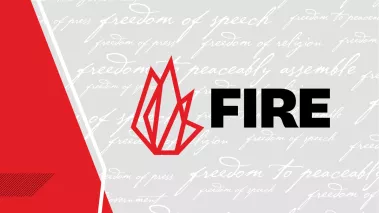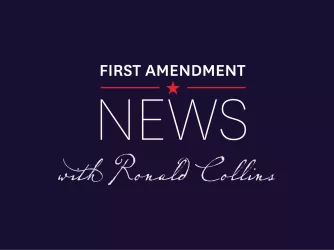Table of Contents
Playing a Dangerous Game

When people think about a “threat,” they tend to imagine a variety of dark scenarios—from the mugger in the alley who says, “Your money or your life,” to the chilling answering machine message where a faceless person says, “I will kill you.” Threats like those have never been considered “free speech.” In fact, true threats are a crime. In general, for a comment to qualify as a true threat, it must cause reasonable people to believe that they are going to be physically harmed.
Unfortunately, many colleges — eager to ban speech that administrators or students do not like — have latched onto the “threat” exception of the First Amendment to justify banning speech that is not actually threatening (as the term has been defined by the law) but instead is merely offensive to the listener. Redefining a “threat” as anything that offends is a dangerous game that discredits accusers, underestimates students’ ability to cope with ideas they dislike, and trivializes the seriousness of actual threats of violence.The latest example of this disturbing trend comes from William Paterson University, a public university in New Jersey. Jihad Daniel, a master’s student and university employee, privately responded to a mass email message sent by a professor, Arlene Holpp Scala, announcing a campus showing of "Ruthie and Connie: Every Room in the House," a film Scala described as a “lesbian relationship story.” The email provided a link so that recipients could contact Scala.
In his response, Daniel, a devout Muslim, wrote, “Do not send me any mail about ‘Connie and Sally’ and ‘Adam and Steve.’ These are perversions. The absence of God in higher education brings on confusion. That is why in these classes the Creator of the heavens and the earth is never mentioned.”
That is the entirety of his response. All too predictably on the contemporary campus, Scala brought charges against Daniel for making her “feel threatened at [her] place of work.” Showing complete disregard of the right to dissent protected under the First Amendment, the university found Daniel guilty of “discrimination” and “harassment.”
Scala’s reliance on the claim that she felt “threatened” is especially disturbing. Did she really fear that this 63-year-old man would harm her, just because they disagree about homosexuality? Yes, many people might find Daniels’ opinion offensive, but the expression of a religious opinion is hardly a threat.
Sadly, Daniel’s case is just one example of how threat allegations are abused on campus. For example, Ursula Monaco, a part-time student at Suffolk County Community College, on Long Island, was punished in 2003 for an e-mail message she accidentally sent to her professor in which she referred to the professor as a “cunt.” Even though that the e-mail was clearly addressed to someone else and that the First Amendment has no exception for even the c-word, Monaco was found guilty of both “harassment” and “intimidation.”
To clarify, “intimidation” in the legal sense is essentially the same thing as a threat and doesn’t occur any time a person feels intimidated; such a vague and broad standard would devour free speech. According to the Supreme Court, intimidation is “a type of true threat, where a speaker directs a threat to a person or group of persons with the intent of placing the victim in fear of bodily harm or death.” Did the Suffolk County professor really believe she was in physical danger because of a single profanity uttered by a 55-year-old grandmother? Unlikely. Yet the administration deemed her guilty of “threatening, intimidating,” and “harassing” the professor. Fortunately, the Foundation for Individual Rights in Education came to Monaco’s defense. After eight months of corresponding with the college, the administration eventually decided to “suspend” the punishments.
It was clear from the start that Suffolk County’s administration had used the e-mail as a pretext for severely punishing Monaco, who was a student journalist and a persistent critic of the administration. Tellingly, her punishment included being banned from having “any contact with the student newspaper,” and stipulated that she “may not contact the office” of any school paper by “any means, including mail, telephone or e-mail,” that she “may not submit articles” to any college paper, or “propose or suggest an article to anyone associated with a campus newspaper.” She was even banned from “approach[ing] any member of the campus community for the purpose of collecting information with which to write a news article.”
For those familiar with history, there is nothing surprising about people in positions of power using perceived exceptions to free speech to silence vocal critics. In fact, the very predictability that cases like Monaco’s will arise is why we must be careful not to allow legitimate exceptions to free speech, like threats, to grow into amorphous, easily abused concepts.
Students are not the only ones harmed by college administrators’ expansive use of the concept of threats. At the University of Alaska at Fairbanks, a professor, Sandra Bond, was punished by the administration for posting two signs on her office in 2003. One said, “The End is Near,” while the other was a K-Mart advertisement for guns and ammunition. The first sign referred to her contract being almost finished and her leaving the university, while she posted the latter because she found K-Mart’s slogan “The Stuff of Life” ironic in an ad for firearms. Bond, who was in her mid-40s — and who walked with a cane due to multiple sclerosis — had apparently scared the criminal justice department so badly that she was found guilty of threatening and intimidating the department, and placed on “administrative leave . . . effective immediately.” They even forbade her from entering her office building without official permission.
Do cases like those at William Patterson, Suffolk and Alaska arise from a pervasive misunderstanding of what “threats” actually mean? The recent case at Washington State University might suggest a more cynical answer. A student, Chris Lee, wrote and produced an intentionally provocative comedy/musical mocking "The Passion of the Christ." In the spirit of "South Park," the play went out if its way to mock everything from race, to religion, to sexual orientation, to stereotypes themselves. To make sure people knew what they were getting into, the play was widely publicized as being potentially “offensive or inflammatory to all audiences,” and identification was checked at the door to prevent those 17 or under from entering.
At the April 21, 2005, performance of the play, approximately 40 student protestors attended. The protestors stopped the play several times with shouts and threats. Unlike those in the cases above, these threats were crystal clear. According to Lee, and a tape of the performance, these threats included, “I kill you,” “You better watch out,” “Get off of there or I’ll mop your fucking head,” “We will get you outside,” and, “We will kill you.” Washington States security refused Lee’s request to remove the protestors and even told Lee to change the lyrics to one of his songs “to avoid a possible riot or physical harm.” As FIRE wrote at the time, “Washington State security’s obligation was to protect the performance — not to enforce the will of a mob that it claimed teetered on the brink of violence.”
Surely, Washington State would not tolerate actual unlawful intimidation of a student production. After all, the university had already produced "The Vagina Monologues," as well as "Tales of the Lost Formicans," which included a depiction of a character masturbating onto an American flag. Certainly, Washington State administrators understood that they must not empower mobs to silence any performances that might offend their sensibilities? Well, they may have understood that, but in this case, they didn’t care. Not only did the president of the university defend the mob’s actions as a “responsible” exercise of their free speech and refuse to reprimand the campus police, but it turns out Washington State actually purchased the tickets for the protestors in the first place!
So in one case a 63-year-old student, and in two others two middle aged women (the taller of the two is 5’4”), are portrayed as placing other adults in mortal terror, while a mob of 40 angry students disrupting a play and shouting death threats is called a “responsible” exercise of free speech!? These kinds of distortions and double standards are all too common on the contemporary campus. The danger posed by the above cases, however, are especially grave. Washington State’s reliance on violent mobs to silence social satire is especially chilling and reminiscent of dark chapters in our history. While in cases like Washington State or Suffolk, the administrators seem to fail to understand that by relying on such a loose definition of “threats” they may undermine how seriously the public takes real claims in the future. It may be time for a refresher course in The Boy Who Cried Wolf 101.
Recent Articles
FIRE’s award-winning Newsdesk covers the free speech news you need to stay informed.

No president gets to decide who deserves a lawyer

Free speech in an age of fear: The new system loyalty oaths – First Amendment News 464

AI is new — the laws that govern it don’t have to be
